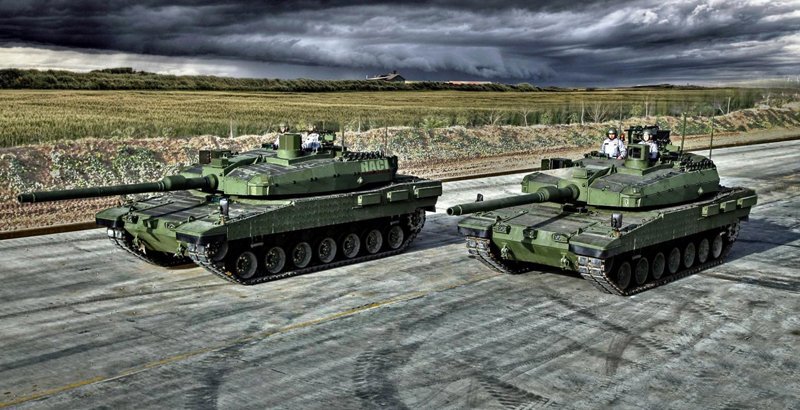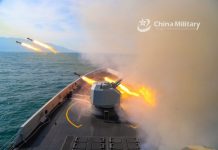Turkey’s long-awaited indigenous main battle tank (MBT) Altay has finally received its engine from South Korean manufacturers. With this news, a significant impediment to the development of Turkey’s domestic tank is addressed.
“The tests of the engine’s power systems are currently underway. We are waiting for May. We will see the prototype of the tank with this engine,” Ismail Demir, the head of Turkey’s Presidency of Defense Industries (SSB), said.
Last year, it was reported that Turkish land vehicle maker BMC, which is leading the Altay project, had reached an agreement with two South Korean businesses, Doosan Infracore Co. and S&T Dynamics Co., for the engine and transmission.
T1 and T2 are the two phases of the Altay program. T1 includes the initial 250 units, whereas, under T2, an enhanced version of the tank will be built. Turkey intended to produce 1,000 Altay under this program, followed by an unmanned variant of the tank.

In a government document published in 2019, President Recep Tayyip Erdogan’s office listed the Altay tank as part of the military’s 2020 inventory. However, the presidential office’s 2021 investment program said nothing about the Altay.
Delays In The Program
In 2007, Anakara signed a $500-million contract with Otokar, a Turkish land systems company, to develop four Altay tank prototypes. The MBT was named after General Fahrettin Altay, who commanded the 5th Cavalry Corps in Turkey’s War of Independence.
The Altay tank was supposed to incorporate the technology of different systems, with Germany transferring technology for its 55-caliber Rh-120 gun, MTU833 engine, and RENK transmission, and South Korean firm Hyundai-Rotem providing the turret layout of its indigenous K2 Black Panther tank for $424 million.
While Turkey had wanted to power the Altay with a German MTU engine and RENK gearbox, talks with German firms have stalled in the past few years due to a federal arms embargo imposed on Turkey. Germany is one of several European governments that have restricted exports to Turkey due to the country’s engagement in the Syrian civil conflict.

Whilst Turkey obtained gun technology from South Korea, Seoul was also working to develop its own engine and transmission and placed the German engine in its early K2 manufacturing.
As a result, Turkey was unable to obtain or manufacture the engine for Altay, thereby disrupting its 2016 production schedule. Furthermore, attempts to buy armor technology utilized on the French Leclerc tank did not succeed due to worsening maritime relations with Paris.
Nevertheless, the Turkish government awarded BMC, a state-owned company, a multibillion-dollar contract for the tank in November 2018. The company won a competition against Otokar, which had already manufactured four Altay prototypes under a government contract.
Some critics believe BMC lacks the experience expected to undertake Altay production quickly, and they see Sancek’s sale of BMC shares last year as alarming.
South Korea’s Growing Defense Industry
South Korea has emerged as a military industry behemoth in its own right in the past decade. The outstanding success of South Korean defense firms follows a decade of reforms, the most recent of which was aimed to consolidate industrial gains and build momentum for growth.
Defense exports have become a higher priority for the country. According to the Stockholm International Peace Research Institute (SIPRI), the country was the 11th largest arms supplier in the world in 2017, with sales totaling $5.5 billion.
SIPRI reported in a 2018 research that South Korea’s defense exports increased by 94 percent in the previous ten years, a figure only surpassed by Turkey for the same timeframe.
This expansion has been fueled by two of South Korea’s most high-profile defense exports in the past decade: the KAI T-50 Golden Eagle family of trainer and light combat aircraft and the Hanwha K9 Thunder self-propelled howitzer.

Hanwha Defense, a South Korean company, announced last month that it will export the K9 self-propelled howitzer and associated support to Egypt in a 2 trillion won ($1.6 billion) deal, the largest-ever supply deal for the locally built weapons system.
Turkey, India, Poland, Finland, Norway, Estonia, and Australia have already deployed or ordered the system.
A South Korean business is also vying for light tank orders for the Indian Army. Larsen & Toubro (L&T), an Indian defense company, is reportedly collaborating with Hanwha Defense to build light tanks for the Indian Army, as previously reported by EurAsian Times.
The two companies previously worked together on the Indian Army’s K9 Vajra-T self-propelled howitzer (SPH), a derivative of the K9 Thunder.
- Contact the author at ashishmichel@gmail.com
- Follow EurAsian Times on Google News




